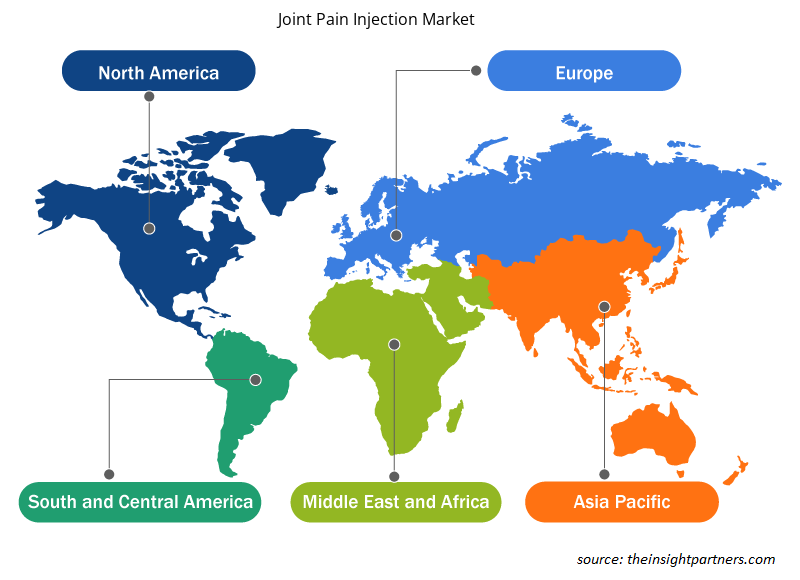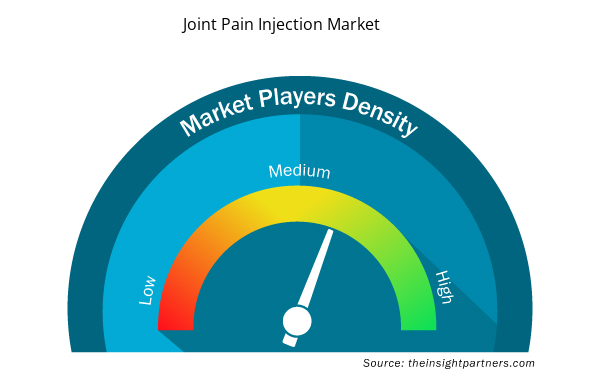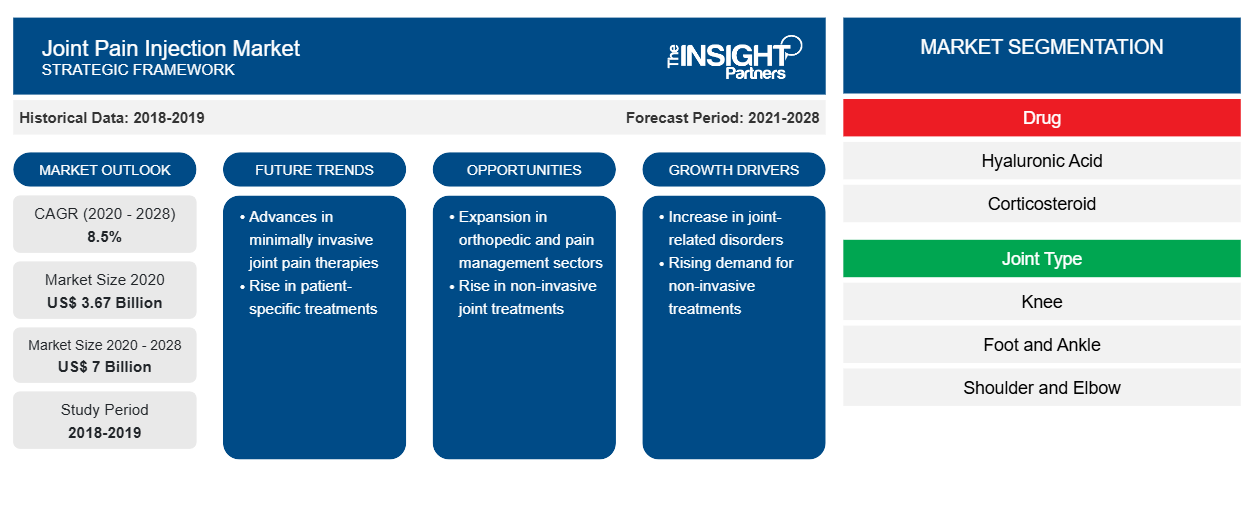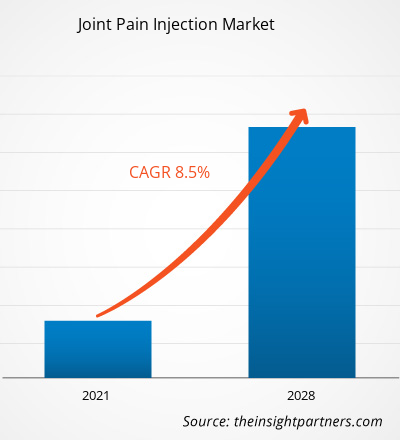[Rapporto di ricerca] Si prevede che il mercato delle iniezioni per il dolore articolare raggiungerà i 6.996,88 milioni di dollari entro il 2028, rispetto ai 3.667,45 milioni di dollari del 2020; si stima che crescerà a un CAGR dell'8,5% nel periodo 2021-2028.
Le iniezioni per il dolore articolare forniscono un sollievo più rapido dal dolore intenso e riducono l'infiammazione delle articolazioni. Diversi tipi di iniezioni disponibili sul mercato includono iniezioni di corticosteroidi, iniezioni di acido ialuronico (HA), iniezioni di plasma ricco di piastrine (PRP) e iniezioni di matrice tissutale placentare (PTM). La crescita del mercato delle iniezioni per il dolore articolare è attribuita a fattori quali l'elevata prevalenza di disturbi muscoloscheletrici e il crescente numero di infortuni sportivi. Tuttavia, gli elevati costi delle terapie di riparazione delle articolazioni ostacolano la crescita del mercato
Approfondimenti di mercato
Alta prevalenza di disturbi muscoloscheletrici
Personalizza questo report in base alle tue esigenze
Riceverai la personalizzazione gratuita di qualsiasi report, comprese parti di questo report, o analisi a livello nazionale, pacchetto dati Excel, oltre a usufruire di grandi offerte e sconti per start-up e università
- Scopri le principali tendenze di mercato in questo rapporto.Questo campione GRATUITO includerà analisi di dati che spaziano dalle tendenze di mercato alle stime e alle previsioni.
I disturbi muscoloscheletrici sono condizioni mediche che colpiscono muscoli, ossa e articolazioni di collo, spalle, polsi, schiena, fianchi, gambe, ginocchia e piedi. Queste malattie includono tendinite, sindrome del tunnel carpale, osteoartrite, artrite reumatoide (AR), fibromialgia e fratture ossee. Secondo la scheda informativa dell'Organizzazione Mondiale della Sanità (OMS) aggiornata nel 2018, le condizioni muscoloscheletriche sono il secondo fattore di disabilità in tutto il mondo. Secondo la stessa, si prevede che la prevalenza e l'impatto dei disturbi muscoloscheletrici aumenteranno con l'aumento dell'invecchiamento della popolazione e l'aumento della prevalenza dei fattori di rischio delle malattie non trasmissibili (NCD) in tutto il mondo. Secondo i dati dell'incontro annuale dell'American Academy of Orthopedic Surgeons del 2016, circa 1 adulto su 2 soffre di un disturbo muscoloscheletrico negli Stati Uniti. Inoltre, secondo i Centers for Disease Control and Prevention (CDC), l'artrite causa un forte dolore che colpisce milioni di persone negli Stati Uniti ogni anno. Circa uno su quattro pazienti affetti da artrite, ovvero circa 15 milioni su un totale di circa 54 milioni di pazienti, soffre di un forte dolore articolare correlato all'artrite.
Inoltre, l'osteoartrite (OA) è uno dei disturbi articolari più comuni negli Stati Uniti, causato dalla rottura della cartilagine articolare tra le ossa. È anche nota come malattia degenerativa delle articolazioni o artrite "da usura". Secondo i Centers for Disease Control and Prevention (CDC), più di 32,5 milioni di adulti negli Stati Uniti soffrono di osteoartrite. Allo stesso modo, secondo il National Health Service (NHS), più di 10 milioni di persone nel Regno Unito soffrono di artrite o altre condizioni simili che colpiscono le articolazioni. Secondo la Bupa Health Insurance, l'osteoartrite è la forma più comune di artrite prevalente nel Regno Unito, colpisce circa un terzo delle persone di età pari o superiore a 45 anni nel paese, ovvero circa 8,75 milioni di persone. Pertanto, una prevalenza così elevata di disturbi muscoloscheletrici in diversi paesi sta aumentando il numero di procedure di trattamento eseguite per gli stessi, guidando così la crescita del mercato delle iniezioni per il dolore articolare.
Approfondimenti basati sui farmaci
Il mercato delle iniezioni per il dolore articolare, per farmaco, è segmentato in acido ialuronico, corticosteroidi e altri. Il segmento dei corticosteroidi ha detenuto la quota maggiore del mercato nel 2020 e si prevede inoltre che registrerà il CAGR più elevato durante il periodo di previsione.
Approfondimenti basati sul tipo di giunto
In base al tipo di articolazione, il mercato delle iniezioni per il dolore articolare è segmentato in ginocchio, piede e caviglia, spalla e gomito, fianchi e altre applicazioni. Il segmento del ginocchio ha detenuto la quota di mercato più grande nel 2020 e si prevede che registrerà il CAGR più alto nel mercato durante il periodo di previsione.
Approfondimenti regionali sul mercato delle iniezioni per il dolore articolare
Le tendenze regionali e i fattori che influenzano il mercato delle iniezioni per dolori articolari durante il periodo di previsione sono stati ampiamente spiegati dagli analisti di Insight Partners. Questa sezione discute anche i segmenti e la geografia del mercato delle iniezioni per dolori articolari in Nord America, Europa, Asia Pacifico, Medio Oriente e Africa e America centrale e meridionale.

- Ottieni i dati specifici regionali per il mercato delle iniezioni per il dolore articolare
Ambito del rapporto di mercato sulle iniezioni per il dolore articolare
| Attributo del report | Dettagli |
|---|---|
| Dimensioni del mercato nel 2020 | 3,67 miliardi di dollari USA |
| Dimensioni del mercato entro il 2028 | 7 miliardi di dollari USA |
| CAGR globale (2020 - 2028) | 8,5% |
| Dati storici | 2018-2019 |
| Periodo di previsione | 2021-2028 |
| Segmenti coperti | Per droga
|
| Regioni e Paesi coperti | America del Nord
|
| Leader di mercato e profili aziendali chiave |
|
Densità dei player del mercato delle iniezioni per dolori articolari: comprendere il suo impatto sulle dinamiche aziendali
Il mercato delle iniezioni per dolori articolari sta crescendo rapidamente, spinto dalla crescente domanda degli utenti finali dovuta a fattori quali l'evoluzione delle preferenze dei consumatori, i progressi tecnologici e una maggiore consapevolezza dei benefici del prodotto. Con l'aumento della domanda, le aziende stanno ampliando le loro offerte, innovando per soddisfare le esigenze dei consumatori e capitalizzando sulle tendenze emergenti, che alimentano ulteriormente la crescita del mercato.
La densità degli operatori di mercato si riferisce alla distribuzione di aziende o società che operano in un particolare mercato o settore. Indica quanti concorrenti (operatori di mercato) sono presenti in un dato spazio di mercato in relazione alle sue dimensioni o al valore di mercato totale.
Le principali aziende che operano nel mercato delle iniezioni per il dolore articolare sono:
- Azienda farmaceutica Chugai
- Società anonima Bioventus Inc.
- Fidia Pharma USA Inc.
- Azienda
- CORPORAZIONE SEIKAGAKU
Disclaimer : le aziende elencate sopra non sono classificate secondo un ordine particolare.

- Ottieni una panoramica dei principali attori del mercato delle iniezioni per il dolore articolare
Informazioni basate sui canali di distribuzione
In base al canale di distribuzione, il mercato delle iniezioni per il dolore articolare è segmentato in farmacie al dettaglio, farmacie ospedaliere e altri. Il segmento della cura delle ferite ha detenuto la quota di mercato più grande nel 2020 e si stima che il segmento degli innesti ossei registrerà il CAGR più alto nel mercato durante il periodo di previsione.
I lanci e le approvazioni di prodotti sono le strategie comunemente adottate dalle aziende per espandere la loro presenza globale e i loro portafogli di prodotti. Inoltre, gli operatori del mercato delle iniezioni per dolori articolari si concentrano sulla strategia di collaborazione per ampliare la loro clientela, il che, a sua volta, consente loro di mantenere il loro marchio a livello globale.
Mercato delle iniezioni per il dolore articolare – per farmaco
- Acido ialuronico
- Corticosteroide
- Altri
Mercato delle iniezioni per il dolore articolare – per tipo di articolazione
- Ginocchio
- Piede e caviglia
- Spalla e gomito
- Anca
- Altri
Mercato delle iniezioni per il dolore articolare – per canale di distribuzione
- Farmacie al dettaglio
- Ospedali Farmacie
- Altri
Mercato delle iniezioni per il dolore articolare – per area geografica
America del Nord
- NOI
- Canada
- Messico
Europa
- Francia
- Germania
- Italia
- Regno Unito
- Spagna
- Resto d'Europa
Asia Pacifico (APAC)
- Cina
- India
- Corea del Sud
- Giappone
- Australia
- Resto dell'Asia Pacifica
Medio Oriente e Africa (MEA)
- Sudafrica
- Arabia Saudita
- Emirati Arabi Uniti
- Resto del Medio Oriente e Africa
America del Sud e Centro (SCAM)
- Brasile
- Argentina
- Resto del Sud e Centro America
Profili aziendali
- Azienda farmaceutica Chugai
- Società anonima Bioventus Inc.
- Fidia Pharma USA Inc.
- Azienda
- CORPORAZIONE SEIKAGAKU
- Ferring BV
- Sanofi
- Azienda
- Teva Farmaceutica
- Azienda
- Analisi storica (2 anni), anno base, previsione (7 anni) con CAGR
- Analisi PEST e SWOT
- Valore/volume delle dimensioni del mercato - Globale, regionale, nazionale
- Industria e panorama competitivo
- Set di dati Excel


- Parking Management Market
- Dropshipping Market
- Vessel Monitoring System Market
- Medical and Research Grade Collagen Market
- Social Employee Recognition System Market
- Identity Verification Market
- Volumetric Video Market
- Intradermal Injection Market
- Blood Collection Devices Market
- Flexible Garden Hoses Market

Report Coverage
Revenue forecast, Company Analysis, Industry landscape, Growth factors, and Trends

Segment Covered
This text is related
to segments covered.

Regional Scope
North America, Europe, Asia Pacific, Middle East & Africa, South & Central America

Country Scope
This text is related
to country scope.
Domande frequenti
The joint pain injection market majorly consists of the players such as Chugai Pharmaceutical Co., Ltd., Teva Pharmaceuticals, Bioventus Inc., Fidia Pharma USA Inc., Flexion Therapeutics, Inc., SEIKAGAKU CORPORATION, Ferring B.V., Sanofi, Anika Therapeutics, Inc., and OrthogenRx among others.
The global joint pain injection market growth is mainly attributed to factors such the high prevalence of musculoskeletal disorders and increasing number of sports injuries. However, the high costs of joint repair therapies hinder the market growth.
Joint pain injections are medicinal fluids inserted in the patient’s body to get faster relief from severe pain. The joint pain injections are used to reduce inflammation in the joints. There are several types of injections available in the market which are corticosteroids injections, hyaluronic acid (HA) injections, platelet-rich plasma (PRP) injections and placental tissue matrix (PTM) injections.
Trends and growth analysis reports related to Life Sciences : READ MORE..
The List of Companies - Joint Pain Injection Market
- Chugai Pharmaceutical Co., Ltd.
- Bioventus Inc.
- Fidia Pharma USA Inc.
- Flexion Therapeutics, Inc.
- SEIKAGAKU CORPORATION
- Ferring B.V.
- Sanofi
- Anika Therapeutics, Inc.
- Teva Pharmaceutical
- OrthogenRx, Inc.
The Insight Partners performs research in 4 major stages: Data Collection & Secondary Research, Primary Research, Data Analysis and Data Triangulation & Final Review.
- Data Collection and Secondary Research:
As a market research and consulting firm operating from a decade, we have published and advised several client across the globe. First step for any study will start with an assessment of currently available data and insights from existing reports. Further, historical and current market information is collected from Investor Presentations, Annual Reports, SEC Filings, etc., and other information related to company’s performance and market positioning are gathered from Paid Databases (Factiva, Hoovers, and Reuters) and various other publications available in public domain.
Several associations trade associates, technical forums, institutes, societies and organization are accessed to gain technical as well as market related insights through their publications such as research papers, blogs and press releases related to the studies are referred to get cues about the market. Further, white papers, journals, magazines, and other news articles published in last 3 years are scrutinized and analyzed to understand the current market trends.
- Primary Research:
The primarily interview analysis comprise of data obtained from industry participants interview and answers to survey questions gathered by in-house primary team.
For primary research, interviews are conducted with industry experts/CEOs/Marketing Managers/VPs/Subject Matter Experts from both demand and supply side to get a 360-degree view of the market. The primary team conducts several interviews based on the complexity of the markets to understand the various market trends and dynamics which makes research more credible and precise.
A typical research interview fulfils the following functions:
- Provides first-hand information on the market size, market trends, growth trends, competitive landscape, and outlook
- Validates and strengthens in-house secondary research findings
- Develops the analysis team’s expertise and market understanding
Primary research involves email interactions and telephone interviews for each market, category, segment, and sub-segment across geographies. The participants who typically take part in such a process include, but are not limited to:
- Industry participants: VPs, business development managers, market intelligence managers and national sales managers
- Outside experts: Valuation experts, research analysts and key opinion leaders specializing in the electronics and semiconductor industry.
Below is the breakup of our primary respondents by company, designation, and region:

Once we receive the confirmation from primary research sources or primary respondents, we finalize the base year market estimation and forecast the data as per the macroeconomic and microeconomic factors assessed during data collection.
- Data Analysis:
Once data is validated through both secondary as well as primary respondents, we finalize the market estimations by hypothesis formulation and factor analysis at regional and country level.
- Macro-Economic Factor Analysis:
We analyse macroeconomic indicators such the gross domestic product (GDP), increase in the demand for goods and services across industries, technological advancement, regional economic growth, governmental policies, the influence of COVID-19, PEST analysis, and other aspects. This analysis aids in setting benchmarks for various nations/regions and approximating market splits. Additionally, the general trend of the aforementioned components aid in determining the market's development possibilities.
- Country Level Data:
Various factors that are especially aligned to the country are taken into account to determine the market size for a certain area and country, including the presence of vendors, such as headquarters and offices, the country's GDP, demand patterns, and industry growth. To comprehend the market dynamics for the nation, a number of growth variables, inhibitors, application areas, and current market trends are researched. The aforementioned elements aid in determining the country's overall market's growth potential.
- Company Profile:
The “Table of Contents” is formulated by listing and analyzing more than 25 - 30 companies operating in the market ecosystem across geographies. However, we profile only 10 companies as a standard practice in our syndicate reports. These 10 companies comprise leading, emerging, and regional players. Nonetheless, our analysis is not restricted to the 10 listed companies, we also analyze other companies present in the market to develop a holistic view and understand the prevailing trends. The “Company Profiles” section in the report covers key facts, business description, products & services, financial information, SWOT analysis, and key developments. The financial information presented is extracted from the annual reports and official documents of the publicly listed companies. Upon collecting the information for the sections of respective companies, we verify them via various primary sources and then compile the data in respective company profiles. The company level information helps us in deriving the base number as well as in forecasting the market size.
- Developing Base Number:
Aggregation of sales statistics (2020-2022) and macro-economic factor, and other secondary and primary research insights are utilized to arrive at base number and related market shares for 2022. The data gaps are identified in this step and relevant market data is analyzed, collected from paid primary interviews or databases. On finalizing the base year market size, forecasts are developed on the basis of macro-economic, industry and market growth factors and company level analysis.
- Data Triangulation and Final Review:
The market findings and base year market size calculations are validated from supply as well as demand side. Demand side validations are based on macro-economic factor analysis and benchmarks for respective regions and countries. In case of supply side validations, revenues of major companies are estimated (in case not available) based on industry benchmark, approximate number of employees, product portfolio, and primary interviews revenues are gathered. Further revenue from target product/service segment is assessed to avoid overshooting of market statistics. In case of heavy deviations between supply and demand side values, all thes steps are repeated to achieve synchronization.
We follow an iterative model, wherein we share our research findings with Subject Matter Experts (SME’s) and Key Opinion Leaders (KOLs) until consensus view of the market is not formulated – this model negates any drastic deviation in the opinions of experts. Only validated and universally acceptable research findings are quoted in our reports.
We have important check points that we use to validate our research findings – which we call – data triangulation, where we validate the information, we generate from secondary sources with primary interviews and then we re-validate with our internal data bases and Subject matter experts. This comprehensive model enables us to deliver high quality, reliable data in shortest possible time.


 Ottieni un campione gratuito per questo repot
Ottieni un campione gratuito per questo repot